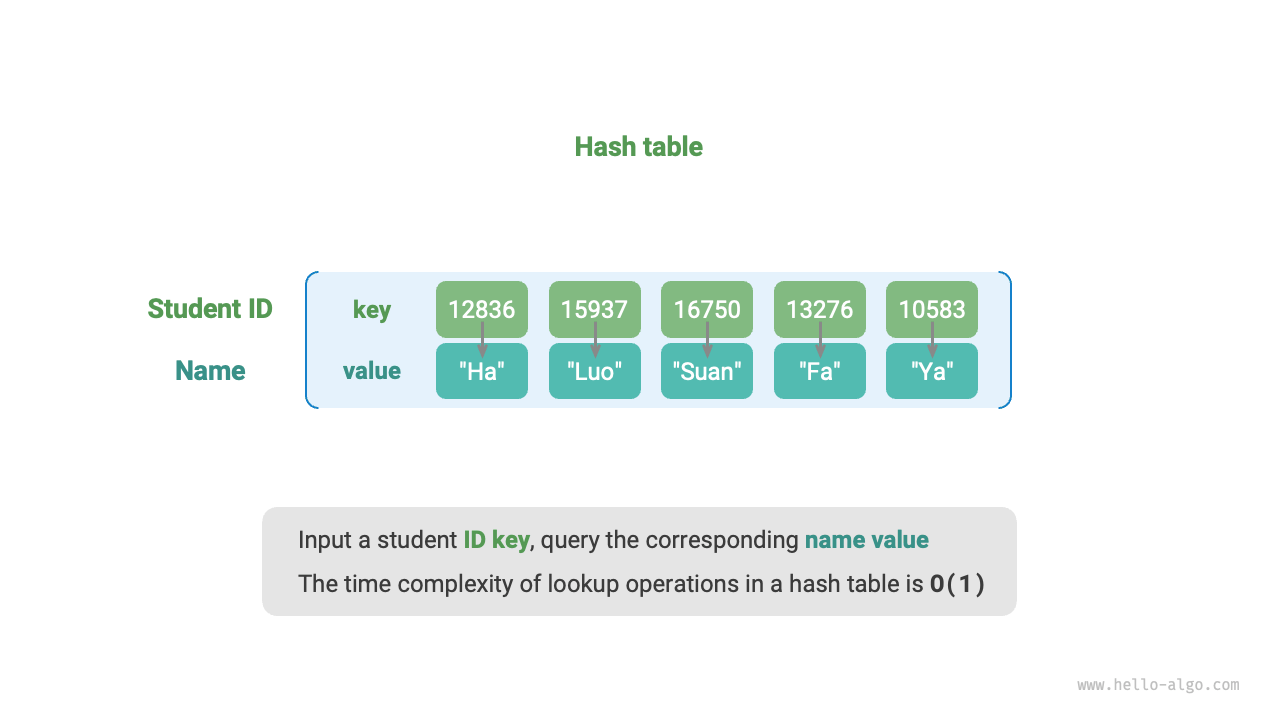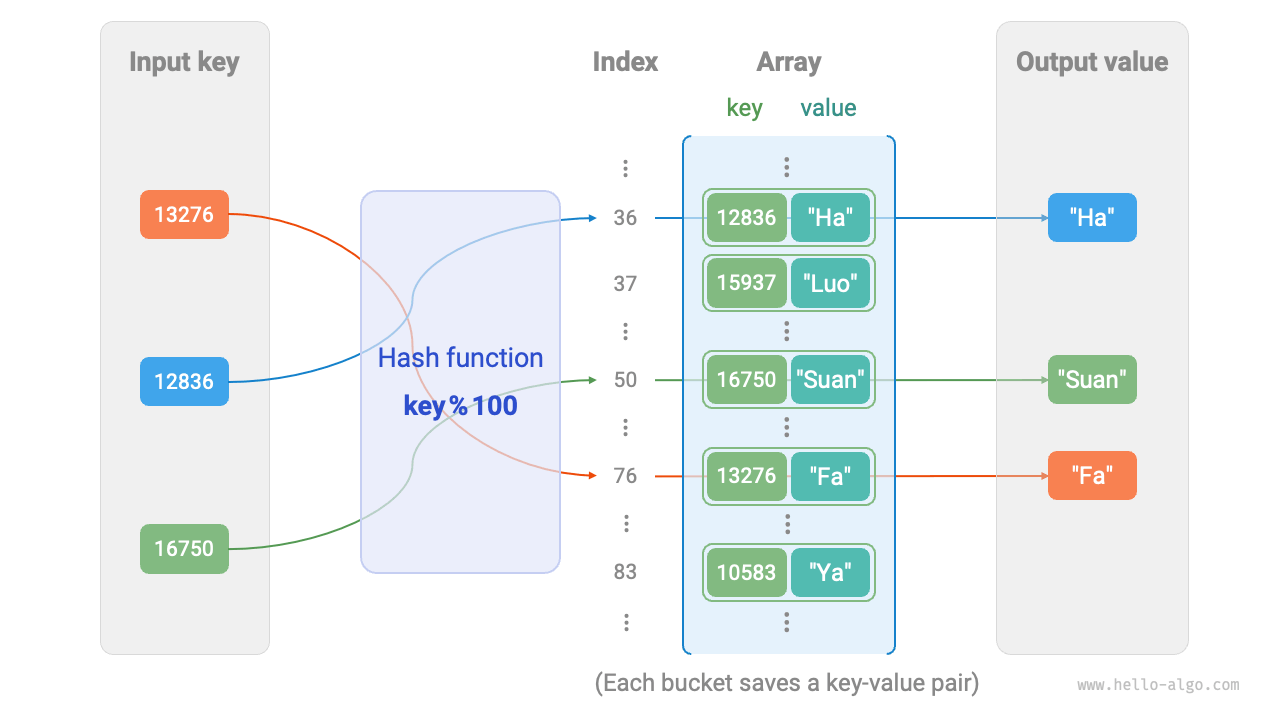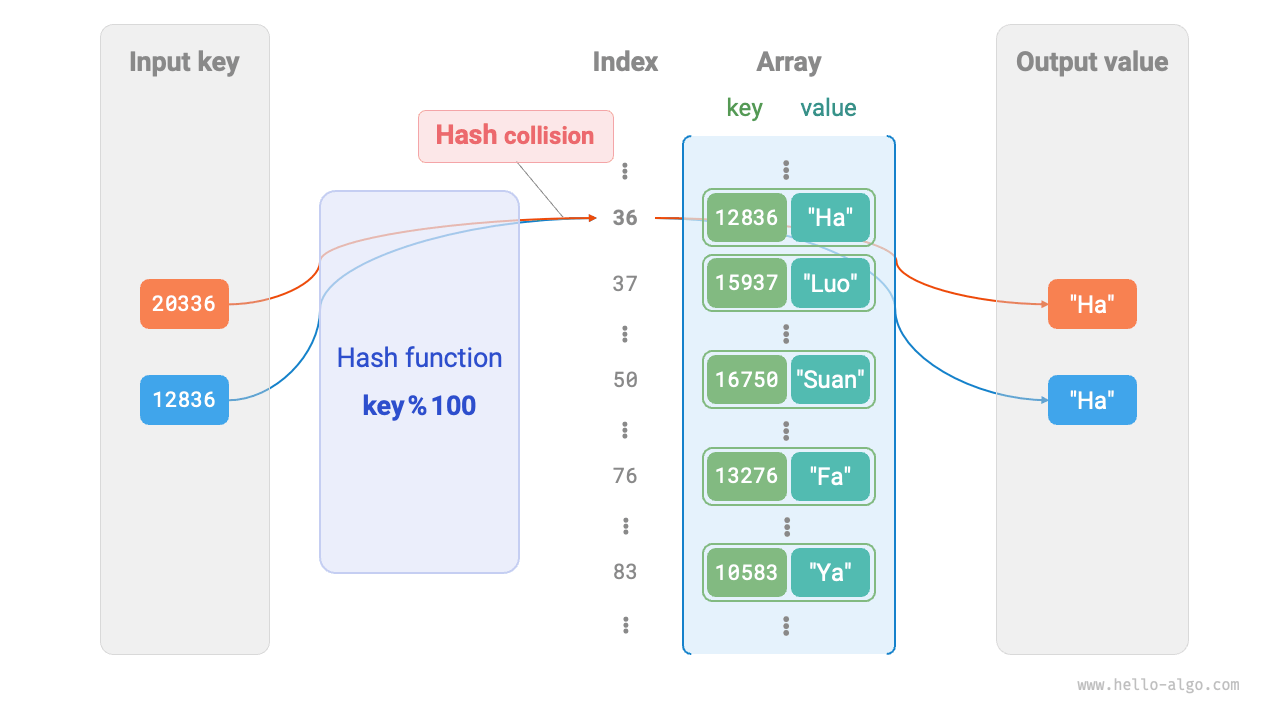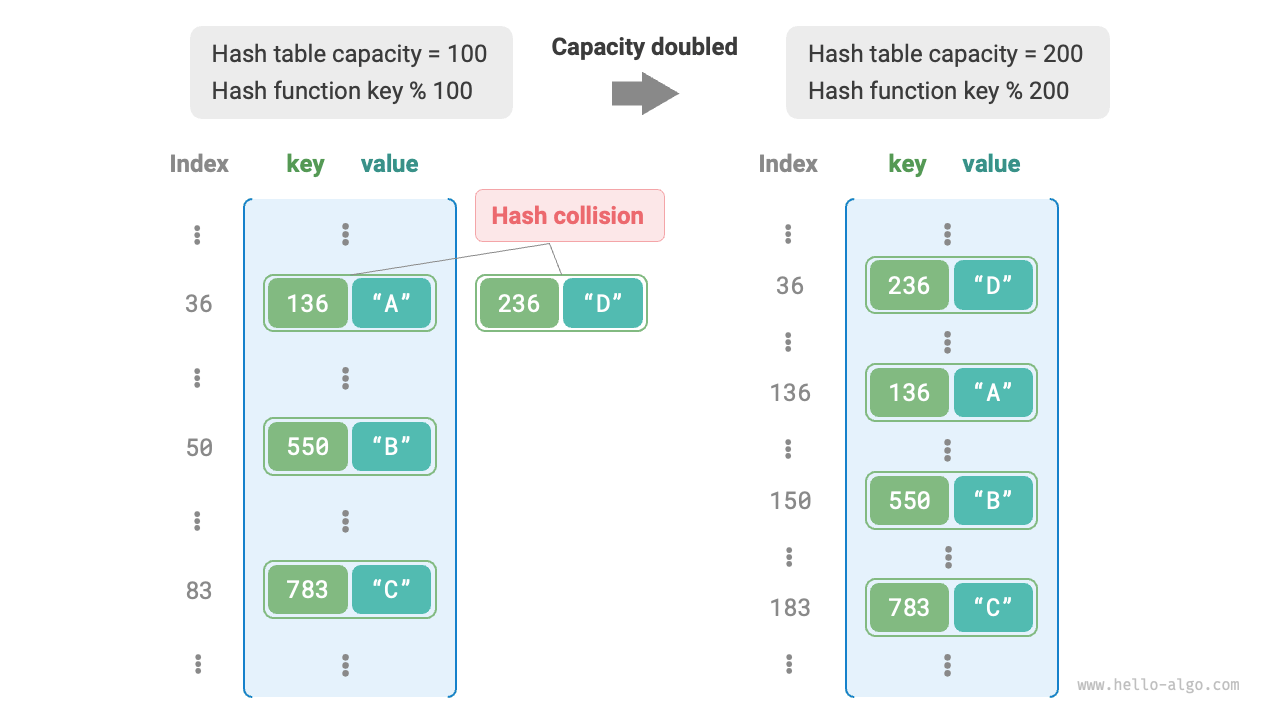# Hash table
A hash table achieves efficient element querying by establishing a mapping between keys and values. Specifically, when we input a `key` into the hash table, we can retrieve the corresponding `value` in $O(1)$ time.
As shown in the figure below, given $n$ students, each with two pieces of data: "name" and "student number". If we want to implement a query feature that returns the corresponding name when given a student number, we can use the hash table shown in the figure below.

Apart from hash tables, arrays and linked lists can also be used to implement querying functions. Their efficiency is compared in the table below.
- **Adding elements**: Simply add the element to the end of the array (or linked list), using $O(1)$ time.
- **Querying elements**: Since the array (or linked list) is unordered, it requires traversing all the elements, using $O(n)$ time.
- **Deleting elements**: First, locate the element, then delete it from the array (or linked list), using $O(n)$ time.
Table Comparison of element query efficiency
| | Array | Linked List | Hash Table |
| -------------- | ------ | ----------- | ---------- |
| Find Element | $O(n)$ | $O(n)$ | $O(1)$ |
| Add Element | $O(1)$ | $O(1)$ | $O(1)$ |
| Delete Element | $O(n)$ | $O(n)$ | $O(1)$ |
Observations reveal that **the time complexity for adding, deleting, and querying in a hash table is $O(1)$**, which is highly efficient.
## Common operations of hash table
Common operations of a hash table include initialization, querying, adding key-value pairs, and deleting key-value pairs, etc. Example code is as follows:
=== "Python"
```python title="hash_map.py"
# Initialize hash table
hmap: dict = {}
# Add operation
# Add key-value pair (key, value) to the hash table
hmap[12836] = "Xiao Ha"
hmap[15937] = "Xiao Luo"
hmap[16750] = "Xiao Suan"
hmap[13276] = "Xiao Fa"
hmap[10583] = "Xiao Ya"
# Query operation
# Input key into hash table, get value
name: str = hmap[15937]
# Delete operation
# Delete key-value pair (key, value) from hash table
hmap.pop(10583)
```
=== "C++"
```cpp title="hash_map.cpp"
/* Initialize hash table */
unordered_map map;
/* Add operation */
// Add key-value pair (key, value) to the hash table
map[12836] = "Xiao Ha";
map[15937] = "Xiao Luo";
map[16750] = "Xiao Suan";
map[13276] = "Xiao Fa";
map[10583] = "Xiao Ya";
/* Query operation */
// Input key into hash table, get value
string name = map[15937];
/* Delete operation */
// Delete key-value pair (key, value) from hash table
map.erase(10583);
```
=== "Java"
```java title="hash_map.java"
/* Initialize hash table */
Map map = new HashMap<>();
/* Add operation */
// Add key-value pair (key, value) to the hash table
map.put(12836, "Xiao Ha");
map.put(15937, "Xiao Luo");
map.put(16750, "Xiao Suan");
map.put(13276, "Xiao Fa");
map.put(10583, "Xiao Ya");
/* Query operation */
// Input key into hash table, get value
String name = map.get(15937);
/* Delete operation */
// Delete key-value pair (key, value) from hash table
map.remove(10583);
```
=== "C#"
```csharp title="hash_map.cs"
/* Initialize hash table */
Dictionary map = new() {
/* Add operation */
// Add key-value pair (key, value) to the hash table
{ 12836, "Xiao Ha" },
{ 15937, "Xiao Luo" },
{ 16750, "Xiao Suan" },
{ 13276, "Xiao Fa" },
{ 10583, "Xiao Ya" }
};
/* Query operation */
// Input key into hash table, get value
string name = map[15937];
/* Delete operation */
// Delete key-value pair (key, value) from hash table
map.Remove(10583);
```
=== "Go"
```go title="hash_map_test.go"
/* Initialize hash table */
hmap := make(map[int]string)
/* Add operation */
// Add key-value pair (key, value) to the hash table
hmap[12836] = "Xiao Ha"
hmap[15937] = "Xiao Luo"
hmap[16750] = "Xiao Suan"
hmap[13276] = "Xiao Fa"
hmap[10583] = "Xiao Ya"
/* Query operation */
// Input key into hash table, get value
name := hmap[15937]
/* Delete operation */
// Delete key-value pair (key, value) from hash table
delete(hmap, 10583)
```
=== "Swift"
```swift title="hash_map.swift"
/* Initialize hash table */
var map: [Int: String] = [:]
/* Add operation */
// Add key-value pair (key, value) to the hash table
map[12836] = "Xiao Ha"
map[15937] = "Xiao Luo"
map[16750] = "Xiao Suan"
map[13276] = "Xiao Fa"
map[10583] = "Xiao Ya"
/* Query operation */
// Input key into hash table, get value
let name = map[15937]!
/* Delete operation */
// Delete key-value pair (key, value) from hash table
map.removeValue(forKey: 10583)
```
=== "JS"
```javascript title="hash_map.js"
/* Initialize hash table */
const map = new Map();
/* Add operation */
// Add key-value pair (key, value) to the hash table
map.set(12836, 'Xiao Ha');
map.set(15937, 'Xiao Luo');
map.set(16750, 'Xiao Suan');
map.set(13276, 'Xiao Fa');
map.set(10583, 'Xiao Ya');
/* Query operation */
// Input key into hash table, get value
let name = map.get(15937);
/* Delete operation */
// Delete key-value pair (key, value) from hash table
map.delete(10583);
```
=== "TS"
```typescript title="hash_map.ts"
/* Initialize hash table */
const map = new Map();
/* Add operation */
// Add key-value pair (key, value) to the hash table
map.set(12836, 'Xiao Ha');
map.set(15937, 'Xiao Luo');
map.set(16750, 'Xiao Suan');
map.set(13276, 'Xiao Fa');
map.set(10583, 'Xiao Ya');
console.info('\nAfter adding, the hash table is\nKey -> Value');
console.info(map);
/* Query operation */
// Input key into hash table, get value
let name = map.get(15937);
console.info('\nInput student number 15937, query name ' + name);
/* Delete operation */
// Delete key-value pair (key, value) from hash table
map.delete(10583);
console.info('\nAfter deleting 10583, the hash table is\nKey -> Value');
console.info(map);
```
=== "Dart"
```dart title="hash_map.dart"
/* Initialize hash table */
Map map = {};
/* Add operation */
// Add key-value pair (key, value) to the hash table
map[12836] = "Xiao Ha";
map[15937] = "Xiao Luo";
map[16750] = "Xiao Suan";
map[13276] = "Xiao Fa";
map[10583] = "Xiao Ya";
/* Query operation */
// Input key into hash table, get value
String name = map[15937];
/* Delete operation */
// Delete key-value pair (key, value) from hash table
map.remove(10583);
```
=== "Rust"
```rust title="hash_map.rs"
use std::collections::HashMap;
/* Initialize hash table */
let mut map: HashMap = HashMap::new();
/* Add operation */
// Add key-value pair (key, value) to the hash table
map.insert(12836, "Xiao Ha".to_string());
map.insert(15937, "Xiao Luo".to_string());
map.insert(16750, "Xiao Suan".to_string());
map.insert(13279, "Xiao Fa".to_string());
map.insert(10583, "Xiao Ya".to_string());
/* Query operation */
// Input key into hash table, get value
let _name: Option<&String> = map.get(&15937);
/* Delete operation */
// Delete key-value pair (key, value) from hash table
let _removed_value: Option = map.remove(&10583);
```
=== "C"
```c title="hash_map.c"
// C does not provide a built-in hash table
```
=== "Kotlin"
```kotlin title="hash_map.kt"
```
=== "Zig"
```zig title="hash_map.zig"
```
??? pythontutor "Code Visualization"
https://pythontutor.com/render.html#code=%22%22%22Driver%20Code%22%22%22%0Aif%20__name__%20%3D%3D%20%22__main__%22%3A%0A%20%20%20%20%23%20%E5%88%9D%E5%A7%8B%E5%8C%96%E5%93%88%E5%B8%8C%E8%A1%A8%0A%20%20%20%20hmap%20%3D%20%7B%7D%0A%20%20%20%20%0A%20%20%20%20%23%20%E6%B7%BB%E5%8A%A0%E6%93%8D%E4%BD%9C%0A%20%20%20%20%23%20%E5%9C%A8%E5%93%88%E5%B8%8C%E8%A1%A8%E4%B8%AD%E6%B7%BB%E5%8A%A0%E9%94%AE%E5%80%BC%E5%AF%B9%20%28key,%20value%29%0A%20%20%20%20hmap%5B12836%5D%20%3D%20%22%E5%B0%8F%E5%93%88%22%0A%20%20%20%20hmap%5B15937%5D%20%3D%20%22%E5%B0%8F%E5%95%B0%22%0A%20%20%20%20hmap%5B16750%5D%20%3D%20%22%E5%B0%8F%E7%AE%97%22%0A%20%20%20%20hmap%5B13276%5D%20%3D%20%22%E5%B0%8F%E6%B3%95%22%0A%20%20%20%20hmap%5B10583%5D%20%3D%20%22%E5%B0%8F%E9%B8%AD%22%0A%20%20%20%20%0A%20%20%20%20%23%20%E6%9F%A5%E8%AF%A2%E6%93%8D%E4%BD%9C%0A%20%20%20%20%23%20%E5%90%91%E5%93%88%E5%B8%8C%E8%A1%A8%E4%B8%AD%E8%BE%93%E5%85%A5%E9%94%AE%20key%20%EF%BC%8C%E5%BE%97%E5%88%B0%E5%80%BC%20value%0A%20%20%20%20name%20%3D%20hmap%5B15937%5D%0A%20%20%20%20%0A%20%20%20%20%23%20%E5%88%A0%E9%99%A4%E6%93%8D%E4%BD%9C%0A%20%20%20%20%23%20%E5%9C%A8%E5%93%88%E5%B8%8C%E8%A1%A8%E4%B8%AD%E5%88%A0%E9%99%A4%E9%94%AE%E5%80%BC%E5%AF%B9%20%28key,%20value%29%0A%20%20%20%20hmap.pop%2810583%29&cumulative=false&curInstr=2&heapPrimitives=nevernest&mode=display&origin=opt-frontend.js&py=311&rawInputLstJSON=%5B%5D&textReferences=false
There are three common ways to traverse a hash table: traversing key-value pairs, keys, and values. Example code is as follows:
=== "Python"
```python title="hash_map.py"
# Traverse hash table
# Traverse key-value pairs key->value
for key, value in hmap.items():
print(key, "->", value)
# Traverse keys only
for key in hmap.keys():
print(key)
# Traverse values only
for value in hmap.values():
print(value)
```
=== "C++"
```cpp title="hash_map.cpp"
/* Traverse hash table */
// Traverse key-value pairs key->value
for (auto kv: map) {
cout << kv.first << " -> " << kv.second << endl;
}
// Traverse using iterator key->value
for (auto iter = map.begin(); iter != map.end(); iter++) {
cout << iter->first << "->" << iter->second << endl;
}
```
=== "Java"
```java title="hash_map.java"
/* Traverse hash table */
// Traverse key-value pairs key->value
for (Map.Entry kv: map.entrySet()) {
System.out.println(kv.getKey() + " -> " + kv.getValue());
}
// Traverse keys only
for (int key: map.keySet()) {
System.out.println(key);
}
// Traverse values only
for (String val: map.values()) {
System.out.println(val);
}
```
=== "C#"
```csharp title="hash_map.cs"
/* Traverse hash table */
// Traverse key-value pairs Key->Value
foreach (var kv in map) {
Console.WriteLine(kv.Key + " -> " + kv.Value);
}
// Traverse keys only
foreach (int key in map.Keys) {
Console.WriteLine(key);
}
// Traverse values only
foreach (string val in map.Values) {
Console.WriteLine(val);
}
```
=== "Go"
```go title="hash_map_test.go"
/* Traverse hash table */
// Traverse key-value pairs key->value
for key, value := range hmap {
fmt.Println(key, "->", value)
}
// Traverse keys only
for key := range hmap {
fmt.Println(key)
}
// Traverse values only
for _, value := range hmap {
fmt.Println(value)
}
```
=== "Swift"
```swift title="hash_map.swift"
/* Traverse hash table */
// Traverse key-value pairs Key->Value
for (key, value) in map {
print("\(key) -> \(value)")
}
// Traverse keys only
for key in map.keys {
print(key)
}
// Traverse values only
for value in map.values {
print(value)
}
```
=== "JS"
```javascript title="hash_map.js"
/* Traverse hash table */
console.info('\nTraverse key-value pairs Key->Value');
for (const [k, v] of map.entries()) {
console.info(k + ' -> ' + v);
}
console.info('\nTraverse keys only Key');
for (const k of map.keys()) {
console.info(k);
}
console.info('\nTraverse values only Value');
for (const v of map.values()) {
console.info(v);
}
```
=== "TS"
```typescript title="hash_map.ts"
/* Traverse hash table */
console.info('\nTraverse key-value pairs Key->Value');
for (const [k, v] of map.entries()) {
console.info(k + ' -> ' + v);
}
console.info('\nTraverse keys only Key');
for (const k of map.keys()) {
console.info(k);
}
console.info('\nTraverse values only Value');
for (const v of map.values()) {
console.info(v);
}
```
=== "Dart"
```dart title="hash_map.dart"
/* Traverse hash table */
// Traverse key-value pairs Key->Value
map.forEach((key, value) {
print('$key -> $value');
});
// Traverse keys only Key
map.keys.forEach((key) {
print(key);
});
// Traverse values only Value
map.values.forEach((value) {
print(value);
});
```
=== "Rust"
```rust title="hash_map.rs"
/* Traverse hash table */
// Traverse key-value pairs Key->Value
for (key, value) in &map {
println!("{key} -> {value}");
}
// Traverse keys only Key
for key in map.keys() {
println!("{key}");
}
// Traverse values only Value
for value in map.values() {
println!("{value}");
}
```
=== "C"
```c title="hash_map.c"
// C does not provide a built-in hash table
```
=== "Kotlin"
```kotlin title="hash_map.kt"
```
=== "Zig"
```zig title="hash_map.zig"
// Zig example is not provided
```
??? pythontutor "Code Visualization"
https://pythontutor.com/render.html#code=%22%22%22Driver%20Code%22%22%22%0Aif%20__name__%20%3D%3D%20%22__main__%22%3A%0A%20%20%20%20%23%20%E5%88%9D%E5%A7%8B%E5%8C%96%E5%93%88%E5%B8%8C%E8%A1%A8%0A%20%20%20%20hmap%20%3D%20%7B%7D%0A%20%20%20%20%0A%20%20%20%20%23%20%E6%B7%BB%E5%8A%A0%E6%93%8D%E4%BD%9C%0A%20%20%20%20%23%20%E5%9C%A8%E5%93%88%E5%B8%8C%E8%A1%A8%E4%B8%AD%E6%B7%BB%E5%8A%A0%E9%94%AE%E5%80%BC%E5%AF%B9%20%28key,%20value%29%0A%20%20%20%20hmap%5B12836%5D%20%3D%20%22%E5%B0%8F%E5%93%88%22%0A%20%20%20%20hmap%5B15937%5D%20%3D%20%22%E5%B0%8F%E5%95%B0%22%0A%20%20%20%20hmap%5B16750%5D%20%3D%20%22%E5%B0%8F%E7%AE%97%22%0A%20%20%20%20hmap%5B13276%5D%20%3D%20%22%E5%B0%8F%E6%B3%95%22%0A%20%20%20%20hmap%5B10583%5D%20%3D%20%22%E5%B0%8F%E9%B8%AD%22%0A%20%20%20%20%0A%20%20%20%20%23%20%E9%81%8D%E5%8E%86%E5%93%88%E5%B8%8C%E8%A1%A8%0A%20%20%20%20%23%20%E9%81%8D%E5%8E%86%E9%94%AE%E5%80%BC%E5%AF%B9%20key-%3Evalue%0A%20%20%20%20for%20key,%20value%20in%20hmap.items%28%29%3A%0A%20%20%20%20%20%20%20%20print%28key,%20%22-%3E%22,%20value%29%0A%20%20%20%20%23%20%E5%8D%95%E7%8B%AC%E9%81%8D%E5%8E%86%E9%94%AE%20key%0A%20%20%20%20for%20key%20in%20hmap.keys%28%29%3A%0A%20%20%20%20%20%20%20%20print%28key%29%0A%20%20%20%20%23%20%E5%8D%95%E7%8B%AC%E9%81%8D%E5%8E%86%E5%80%BC%20value%0A%20%20%20%20for%20value%20in%20hmap.values%28%29%3A%0A%20%20%20%20%20%20%20%20print%28value%29&cumulative=false&curInstr=8&heapPrimitives=nevernest&mode=display&origin=opt-frontend.js&py=311&rawInputLstJSON=%5B%5D&textReferences=false
## Simple implementation of hash table
First, let's consider the simplest case: **implementing a hash table using just an array**. In the hash table, each empty slot in the array is called a bucket, and each bucket can store one key-value pair. Therefore, the query operation involves finding the bucket corresponding to the `key` and retrieving the `value` from it.
So, how do we locate the appropriate bucket based on the `key`? This is achieved through a hash function. The role of the hash function is to map a larger input space to a smaller output space. In a hash table, the input space is all possible keys, and the output space is all buckets (array indices). In other words, input a `key`, **and we can use the hash function to determine the storage location of the corresponding key-value pair in the array**.
The calculation process of the hash function for a given `key` is divided into the following two steps:
1. Calculate the hash value using a certain hash algorithm `hash()`.
2. Take the modulus of the hash value with the number of buckets (array length) `capacity` to obtain the array index `index`.
```shell
index = hash(key) % capacity
```
Afterward, we can use `index` to access the corresponding bucket in the hash table and thereby retrieve the `value`.
Assuming array length `capacity = 100` and hash algorithm `hash(key) = key`, the hash function is `key % 100`. The figure below uses `key` as the student number and `value` as the name to demonstrate the working principle of the hash function.

The following code implements a simple hash table. Here, we encapsulate `key` and `value` into a class `Pair` to represent the key-value pair.
```src
[file]{array_hash_map}-[class]{array_hash_map}-[func]{}
```
## Hash collision and resizing
Fundamentally, the role of the hash function is to map the entire input space of all keys to the output space of all array indices. However, the input space is often much larger than the output space. Therefore, **theoretically, there must be situations where "multiple inputs correspond to the same output"**.
For the hash function in the above example, if the last two digits of the input `key` are the same, the output of the hash function will also be the same. For example, when querying for students with student numbers 12836 and 20336, we find:
```shell
12836 % 100 = 36
20336 % 100 = 36
```
As shown in the figure below, both student numbers point to the same name, which is obviously incorrect. This situation where multiple inputs correspond to the same output is known as hash collision.

It is easy to understand that the larger the capacity $n$ of the hash table, the lower the probability of multiple keys being allocated to the same bucket, and the fewer the collisions. Therefore, **expanding the capacity of the hash table can reduce hash collisions**.
As shown in the figure below, before expansion, key-value pairs `(136, A)` and `(236, D)` collided; after expansion, the collision is resolved.

Similar to array expansion, resizing a hash table requires migrating all key-value pairs from the original hash table to the new one, which is time-consuming. Furthermore, since the capacity `capacity` of the hash table changes, we need to recalculate the storage positions of all key-value pairs using the hash function, which adds to the computational overhead of the resizing process. Therefore, programming languages often reserve a sufficiently large capacity for the hash table to prevent frequent resizing.
The load factor is an important concept for hash tables. It is defined as the ratio of the number of elements in the hash table to the number of buckets. It is used to measure the severity of hash collisions and **is often used as a trigger for resizing the hash table**. For example, in Java, when the load factor exceeds $0.75$, the system will resize the hash table to twice its original size.